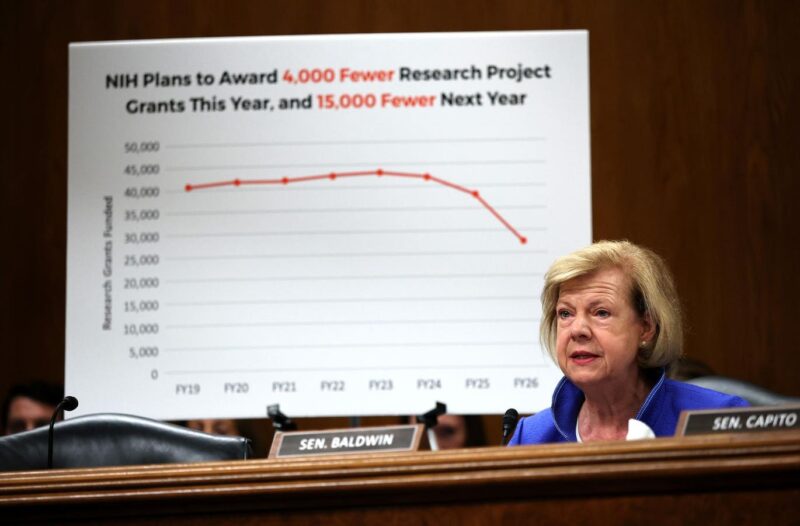U.S. Sen. Tammy Baldwin (D-WI) sits in front of a graph that shows how the National Institutes of Health (NIH) will be funding a lto fewer grants this year and next during her questioning of NIH director Jayanta Bhattacharya. (Photo by Win McNamee/Getty Images)
Getty Images
If you were told that you had to do hard work where you’d have about a one-in-ten chance of getting paid, would you do it? Well, those were the odds that scientific researchers in the U.S. had been facing for years when putting in all the blood, sweat and years that it takes to apply for National Institute of Health grants. The emphasis is on the words “had been” here as things have gotten, guess what, even worse this year.
Yep, those were the supposed “good old days” before U.S. President Donald Trump took office in January. Since then the Trump Administration has taken a series of actions to make it that much harder for scientists to get the NIH grants that they often depend on to pay themselves and their teams so that everyone can, you know, maintain their jobs, do science, feed their families, wear clothes and all that stuff.
How The New Multiyear NIH Funding Policy Works
For example, this newly installed multiyear funding policy for NIH grants has dropped the funding rates for National Cancer Institute grants from around one in 10 applicants down to a what-the-heck one in 25. That’s the NCI with the word “cancer” in the middle of its name, meaning you’re talking about fewer grants looking at how to prevent and treat cancer, stuff that’s kind of good for all of society. Talk about turning frowns even more down.
To understand how the Trump Administration is changing things with the multiyear funding policy, let’s first look at how the NIH had long decided on how many grants to fund before the second coming of Trump. For years, each NIH institute would look at its budget for the year and from that establish how many different grants it could cover for that year.
For example, in 2024, the NCI was able to award around $4.2 billion in external funding. To determine how many grants it could award that year, the NCI looked at what each of the different grants would cost just that year, meaning in 2024. For example, a five-year grant that would span 2024 through 2029 might eevntually end up costing a total of around $5 million. But for 2024 alone this grant would cost only a fifth of this total, namely a little under a million dollars. The NCI would then say, “Hey, can we afford to pay out a million dollars for this grant in 2024?” If so and if the scientific peer-review porcess decided that the grant was worthwhile and feasible and if the NCI determined the grant to be within its priorities, then the scientific team and its institution would get the funding. That’s a lot of if ands.
Well, the Trump Administration has since introduced a lot more buts as in let’s further kick the butts of scientific researchers and science. This new multiyear funding policy installed this Summer now requires the institute to have all the funding available for the entire lifetime of the grant already in the year that the grant will be started. So, with the five year, five million dollar grant example, to award it in 2025, all five million dollars would have to be available in the 2025 budget. That’s even though the NCI would not pay that scientific research team and institution the whole sum in 2025 and that most of it would be outlaid in future years.
The Problems With The NIH Multiyear Funding Policy
Let’s see how such a policy would work in other arenas. Imagine what would happen if a company could only hire people if they already had all the money needed to pay each employee for the entire time that employee would be working at the company. Many companies would be able to hire a grand total of zero people.
How about the investment arena? What if an investor said, “I’m only going to invest in a company if I currently have all the money that I will ever invest in that company for the lifetime of the company?” Yeah, a lot of companies would have never survived had that been the case. Look at Facebook or Meta as it’s called these days for example. For years, the company wasn’t even making money. Yet, investors kept piling funds into the company year after year. A multi-year investment requirement would have left Meta to be more like feta, crumbling.
Want another example? Say, you wanted to construct something like, oh, a ball room. What if you could only do it if you had all the money upfront for the entire construction and operations of the ball room for the next five years? That’s every electricity and water bill, every meal, every guest expense and every gold statuette and gold-plated anything that goes into the ballroom. Think everyone would be on the ballroom for that?
As you can see, what’s being done with NIH funding is pretty unprecedented. No other profession, industry or sector works that way. When a decision-maker or organization decides to commit to a person or a project that may be around for more than one year, they don’t tend to ask, “Do I have all the money that I am ever going to pay that person or project in my pocket right now?”
The Multiyear Funding Policy Means Much Fewer NIH Grants Will Be Awarded
Let’s do the math and see how all of this will reduce the number of grants awarded by the NIH. A typical NIH grant is three to five years long. That’s because it is really hard to do anything of substance in less than three years. The first year is usually spent hiring the right people, setting up the appropriate contracts, purchasing the needed equipment and getting things going in general. The second year is when you are actually running the experiments or what have you. Results don’t tend to start coming in until the third year with an emphasis on the word “start.” If the work is more complex or anything happens to go unexpectedly, because after all you are experimenting, then the results generating phase can easily be pushed into years four and five.
So, using a four-year grant as a middle estimate, take a look at the impact of this new requirement to have funding for all four years of each grant already in an NIH institute’s current budget rather than just one of the years. That would mean the institute could only fund a quarter of the grants that it normally fund in a given year. You are talking about 80% of the projects that would have gotten funding no longer being in the mix. That’s why the chances of getting a grant from the NCI has now plummeted from a really tough 10% to a holy-bleep-how-are-we-going-to-do-this 4%.
That’s effectively a huge cut of scientific funding. It’s not a shift to gold standard science. It’s not a shift in scientific priorities. It’s not a shift to anything you want to say besides less funding for real science. Instead, it’s in line with the Trump administration’s request to Congress to cut the NIH’s budget by about 40% in 2026.
NIH Funding Cuts Are Being Made Without The Approval Of Scientists, Congress Or The Many Patients Affected
But, and it’s a big butt one cannot lie, the implementation of this new multiyear-funding-policy-enabled cut of the NIH’s effective grant budget has been done without the approval of Congress. It’s been done without much input from the scientific community, patients who will be impacted by the loss of science or the public in general either. That’s been the case with other NIH changes that have been implemented by the Trump administration and I have detailed earlier this year in Forbes such as attempting to slash funding for indirect costs, making certain commonly-used terms like “women” or “female” red flags that could potentially lead to grant termination and blocking the issuing of grant funding.
Normally, when the NIH want to make a change in its policies, it will first issue a request for information, otherwise known as an RFI, to get thoughts from everyone who may be affected by the policy, especially scientists. Then the NIH will consider anything they receive in a public forum so things are, you know, rather transparent.
But with most of the NIH changes this year, there’s been no RFI. Unless you are talking about an acronym for “really freaking incredible.” It’s also been more of just an “I” situation, as in seemingly one person or at most only a few people declaring that a change in NIH will occur and leaving not much room for discussion. That is not how science is supposed to work and sets a very bad precedent. What if only a few people in the U.S. have more and more power to dictate what science is done and what scientists say in the U.S.? That could allow more and more misinformation and disinformation to proliferate and thus concentrate power among fewer and fewer people.
Why What’s Happening At The NIH Affects Everyone
Now, it may seem easy to ignore what’s happening with the NIH if you are not one of those scientists clawing for survival. But all of this will eventually affect everyone. It certainly will affect if you work at any university or other research institution. Your salary and benefits could be paid by NIH funding without you even knowing it. This could be directly if you work for a research project, group or center. Or it could be indirectly if you are somehow being paid by a university or organization through indirect costs. So, if such is the case, bye, bye funding, bye-bye your job.
Such things tend to have trickle down or up economic effects. Universities and healthcare systems often are the biggest employers and consumers in a town or city. If they aren’t doing well, lots of other surrounding businesses won’t be doing well. And guess where all those pharmaceutical companies, medical device companies, tech companies and various consumer companies get a lot of their products, inventions and intellectual property. The answer rhymes with scientists because it is scientists.
Finally, and you should probably pay attention to this if you have either a head or body, science funded specifically by the NIH helps identify and shape ways to maintain health and prevent and treat diseases. For example, unless you have a strong desire to get and die from cancer, the work supported by NCI will benefit you and those you love.
It’s not as if NIH funding was great before 2025. The last time the NIH enjoyed a big funding bump was in the late 1990s. Since then NIH funding has barely kept up with inflation, even though science has gotten more complex and thus difficult to do. The chances of getting NIH grants have been steadily declining over the past two decades. The Trump administration has only greatly accelerated that decline. The question then is how long will this decline is science funding be allowed before the resulting decline of the U.S. is clearly seen by everyone.









